Last updated: March 8, 2025
Article
Bats Are in Danger. Here’s How and Why We’re Helping Them.
Bats are amazing animals and a formidable force against insect pests, but a nasty fungal disease is killing them. A coordinated national response brings hope.
By Michelle Verant, Bik Wheeler, Mark Ford, Ian Abernethy, Rob Schorr, Allen Calvert, Bryan Hamilton, and Kimber Godfrey
Image credit: NPS / Bryan Hamilton
You may find them creepy or cool when they swoop overhead as twilight descends upon your neighborhood.
Either way, without bats, you can say hello to higher prices at your local supermarket. These nocturnal flying mammals save U.S. agriculture over three billion dollars annually by eating insect pests (a nursing mother bat can eat more than 4,000 in one night). Some species pollinate important plants like agave. But bats face threats from climate change, habitat loss, declining insect populations, collisions with wind turbines, and white-nose syndrome, a deadly fungal infection. Experts estimate that 52 percent of the 145 species of bats in North America need conservation action to avoid severe population declines over the next 15 years.
The fungus that causes white-nose syndrome is aptly named Pseudogymnoascus destructans. It first appeared in the U.S. in 2006, in New York State, and is now in most U.S. states and Canadian provinces. Bats in North America used to survive winter by hibernating until their insect prey re-emerged in the spring. But this fungus loves the same cold, damp conditions that hibernating bats like, which means bats often become infected and die from the disease before spring arrives. This fungus has caused populations of some species to plummet by 90 percent, raising the specter of their extinction.
In response to this threat, the National Park Service teamed up with over 150 partner agencies and organizations nationally to combat white-nose syndrome and conserve bats. Scientific research and stewardship in parks across the country help protect bat habitat, monitor populations, prevent disease spread, and educate visitors on how they can help save these fascinating creatures.
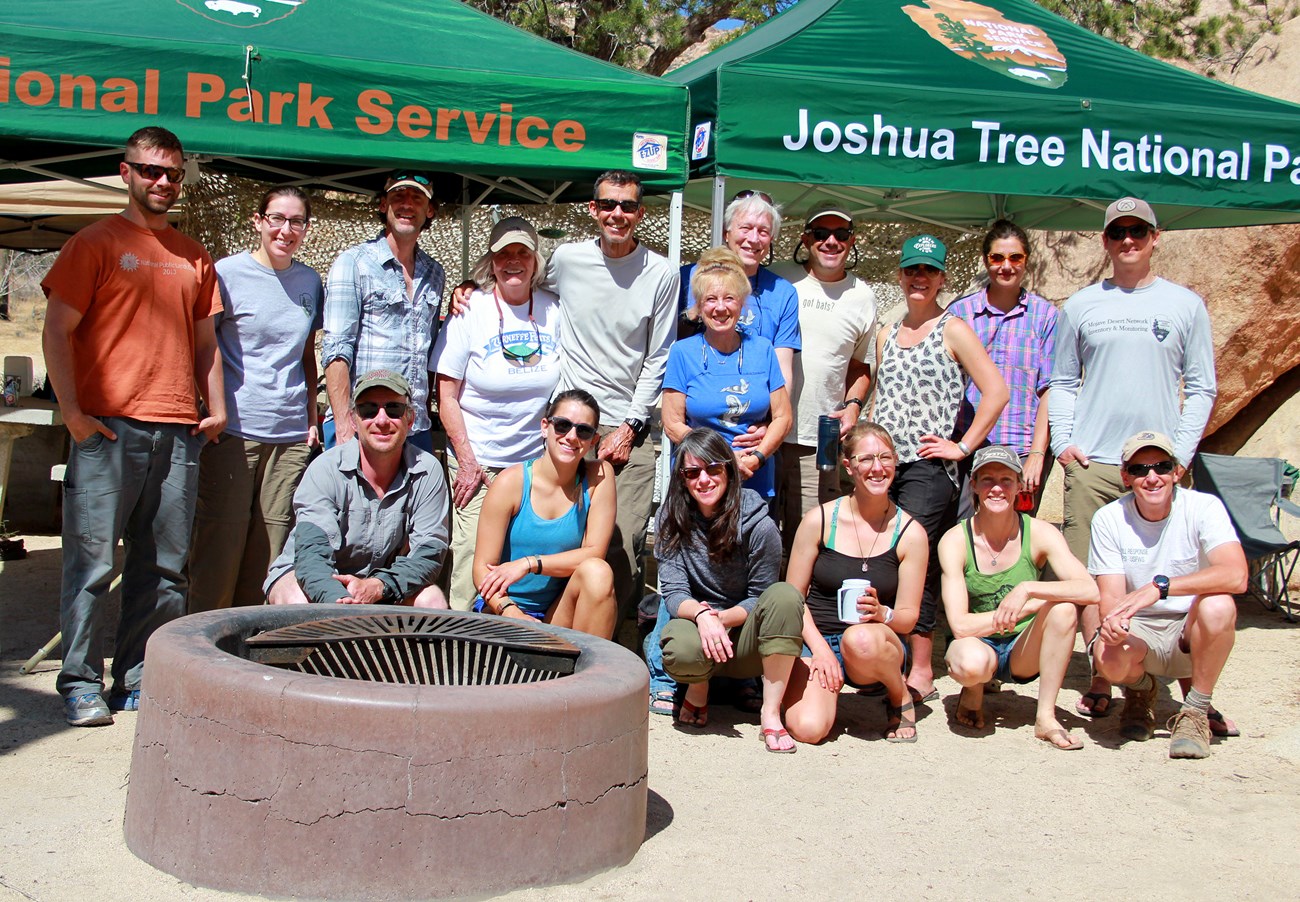
Image credit: NPS
Dispersed Habitat May Be Key to Acadia Survivors
New York, where white-nose syndrome first appeared, is approximately 400 miles from Acadia National Park’s rocky shores. The park began studying its bat community in earnest in 2008 to gather baseline data, collecting information about the bats’ condition before the disease arrived. Sure enough, in the winter of 2011–2012, park biologists detected the disease. By 2013, some of Acadia's bat species had declined by 90 percent. The data the park collected before and after arrival of white-nose syndrome helped scientists determine its impacts and which species were hit the hardest.
The species most affected at Acadia are the tri-colored bat, eastern-small footed bat, little brown bat, and northern long-eared bat. The U.S. Fish and Wildlife Service listed the latter as endangered because of severe population declines caused by white-nose syndrome. The agency also proposed listing the tri-colored bat as endangered and is reviewing the little brown bat for listing.
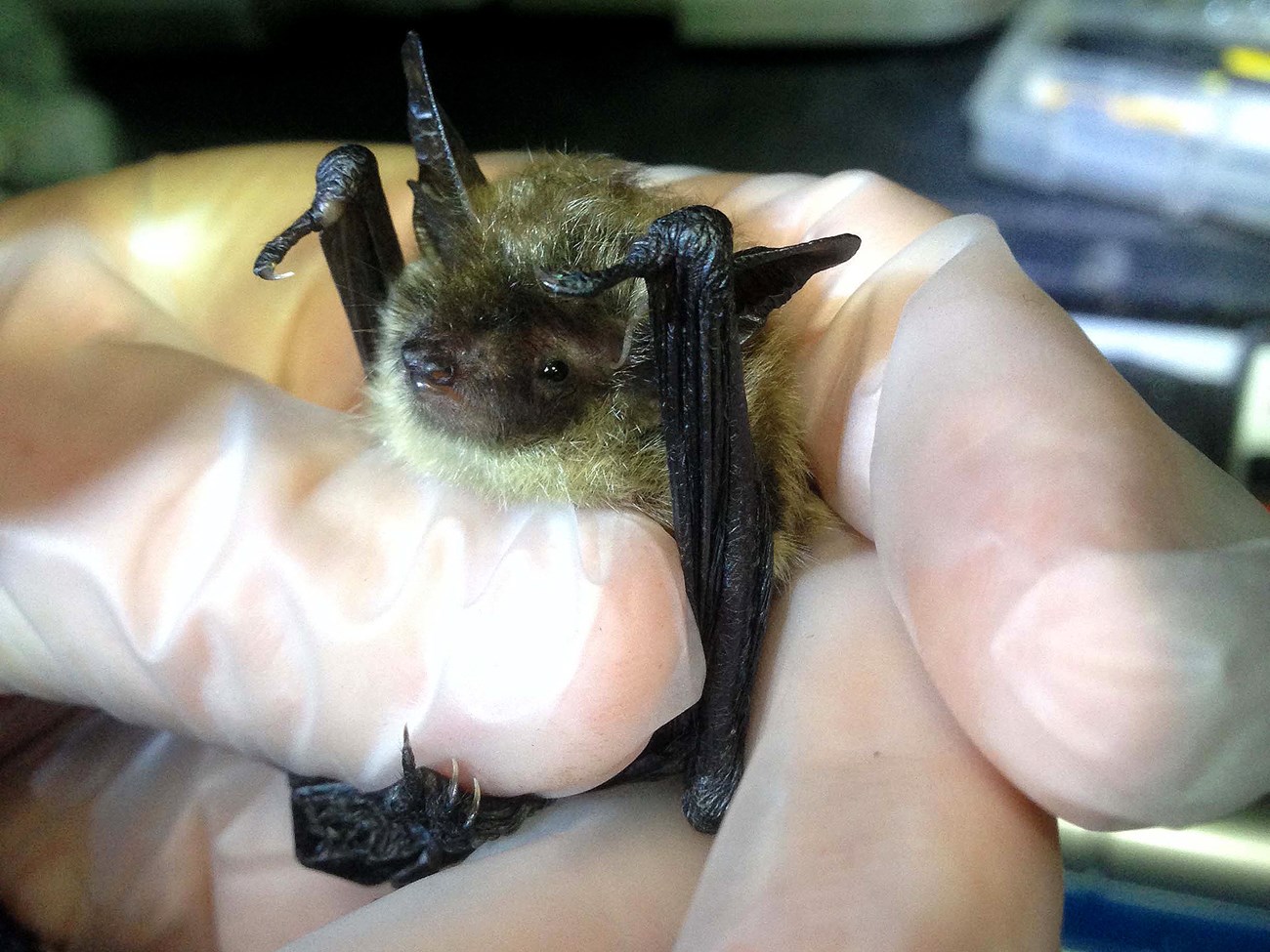
Image credit: NPS / Morgan Ingalls
But researchers have identified some bats in the park that are not only surviving this disease but thriving. In 2022, Acadia recaptured an eastern small-footed bat that was banded before white-nose syndrome arrived, over 10 years ago. Scientists recapture eastern small-footed bats here year after year, showing they are committed to this location. Networks of maternity roosts, where female bats gather to give birth and raise pups, likely support generations of bats.
Bats live up to 30 years and reproduce slowly. A mother bat only has one pup per year, so protecting reproductive habitat is vital. By monitoring bats in the park, Acadia can identify where they roost, feed, or breed, sometimes in historic structures like the Brown Mountain Gatehouse. Park managers use this information to minimize harmful impacts on bats when planning construction and rehabilitation.
Bats that spend the winter here are using other types of hibernacula, like cracks and crevices in rocky outcrops.
Bats typically use caves or abandoned mines for hibernation, which are called hibernacula, but there are no known caves or mines in or near Acadia. Bats that spend the winter here are using other types of hibernacula, like cracks and crevices in rocky outcrops. These are abundant in the park’s glacially sculpted granite landscape. It is possible that these dispersed, well-hidden hibernacula help bats survive the disease during their vulnerable hibernation, but that story is yet to unfold.
Long-term population trends of bats in Acadia show that white-nose syndrome has had a devastating effect. But the discovery of individual bats surviving the disease for over a decade is promising. Understanding whether bats’ roost choices affect their survival can help land managers prioritize locations and actions to support bat populations in and outside the park.
Urban DC Bats Survive Even as Rural Ones Don’t
At national parks in the Washington, DC, metro area, bat researchers from Virginia Tech and U.S. Geological Survey have found surviving and reproducing northern long-eared bats since 2014. Through this work, scientists have gained insights into the ecology of these previously unknown, urban remnant populations. This is essential knowledge for protecting the species. In contrast, the maternity colonies in the nearby Blue Ridge Mountains of Shenandoah National Park went from being reproductively successful in 2014 to present but unsuccessful in 2017. Long-eared bats have nearly disappeared from the area because of the deadly effects of white-nose syndrome.
Bats can be hard to find and study, as they are small and nocturnal. They make high-frequency sounds—echolocations—when they are navigating and foraging for insects. These calls are mostly above the range of human hearing, but scientists use acoustic detectors to listen for them. The detectors help researchers identify which species of bats made them.

Image credit: U.S. Geological Survey / Mark Ford
Data from acoustic detectors and mist-net captures suggest that some northern long-eared bats might be spending the winter in the urban DC area rather than heading into Appalachian Mountain caves. Other northern long-eared bats could be migrating south for the winter along the Virginia and North Carolina coast to forested wetlands. Unpublished data show bats in the DC area are genetically related to bats in eastern North Carolina. That suggests this I-95 corridor population has persisted for years. Such relatively long-distance migrations are atypical for this species.
These bats may be resisting infection by avoiding caves with the fungus and remaining in warmer climates that allow them to feed and groom during winter.
But white-nose syndrome may have given the bats a good reason to make the trip. Temperatures are warm enough along the southern Atlantic coast during winter to forego traditional hibernation. These bats may be resisting infection by avoiding caves with the fungus and remaining in warmer climates that allow them to feed and groom during winter.
In the summer, female northern long-eared bats use trees and snags—standing dead trees—for roosting and raising young. Understanding what types of trees and forest conditions the bats prefer is critical for conserving them. But trying to find a bat nestled into a hole in a tree is like trying to find a needle in a 50-foot tall haystack. For this reason, researchers temporarily attach tiny radio transmitters smaller than a dime to the back of bats captured during mist netting.
The transmitters emit a very high frequency radio signal, which radio receivers and antennae pick up, helping locate the bats’ roost. It’s not easy, as the tag remains on the bat for only a few days, and the transmission range is no more than half a mile. But by catching and radio-tagging female northern long-eared bats at DC area parks in summer, scientists can describe the types of day roosts and forest conditions this species prefers.
Visitors to DC in summer agree it can be brutally hot. Bats feel the same way. In cooler areas of the northeastern U.S. and Appalachians, female northern long-eared bats roost in smaller trees or snags, arranging themselves like candy in a Pez dispenser. The trees are in open canopies with full sunlight, making these roosts nice and warm, which speeds the growth and development of baby bats. But in the warmer DC area, female northern long-eared bats use small red maple or American beech trees that are completely under the cool shade of the forest overstory. Maternal colonies tend to be in older areas of the forest. Solitary adult males are less choosy.
Data from these studies have helped the U.S. Fish and Wildlife Service set survey standards for this imperiled species. A key question is how much effort is required using either acoustic or mist-netting surveys to conclude the species is present or absent. These annual surveys help answer that question and show how rates of detection change over time or across park size and habitat quality. Long-term studies such as the North American Bat Monitoring Program also use these data. The ending to the story of white-nose syndrome has not yet been written for North American bats. But the persistence of northern long-eared bats in our nation’s capital provides a glimmer of hope for this endangered species.
Bats Love the (Long) Island Life Too
There is a unique maternity colony of northern long-eared bats living on Long Island, New York. This species has largely disappeared from most of the northeastern U.S. because of white-nose syndrome. But a few colonies persist, such as on Mount Desert Island, Maine, home of Acadia National Park; on Martha’s Vineyard and Nantucket Island in Massachusetts; and on Long Island, east of New York City. What draws these bats to island living? It’s not the scenic beaches or great pizzerias. It’s the trees and the insects.
The National Park Service manages a 200-acre patch of upland forest on Long Island, on the historic estate of William Floyd, a signer of the Declaration of Independence. The estate is a portion of Fire Island National Seashore. It is surrounded on three sides by an urban landscape and on the other side, by the Atlantic Ocean. But the estate provides exactly what northern long-eared bats need—lots of trees for roosting and an abundance of insects to eat.
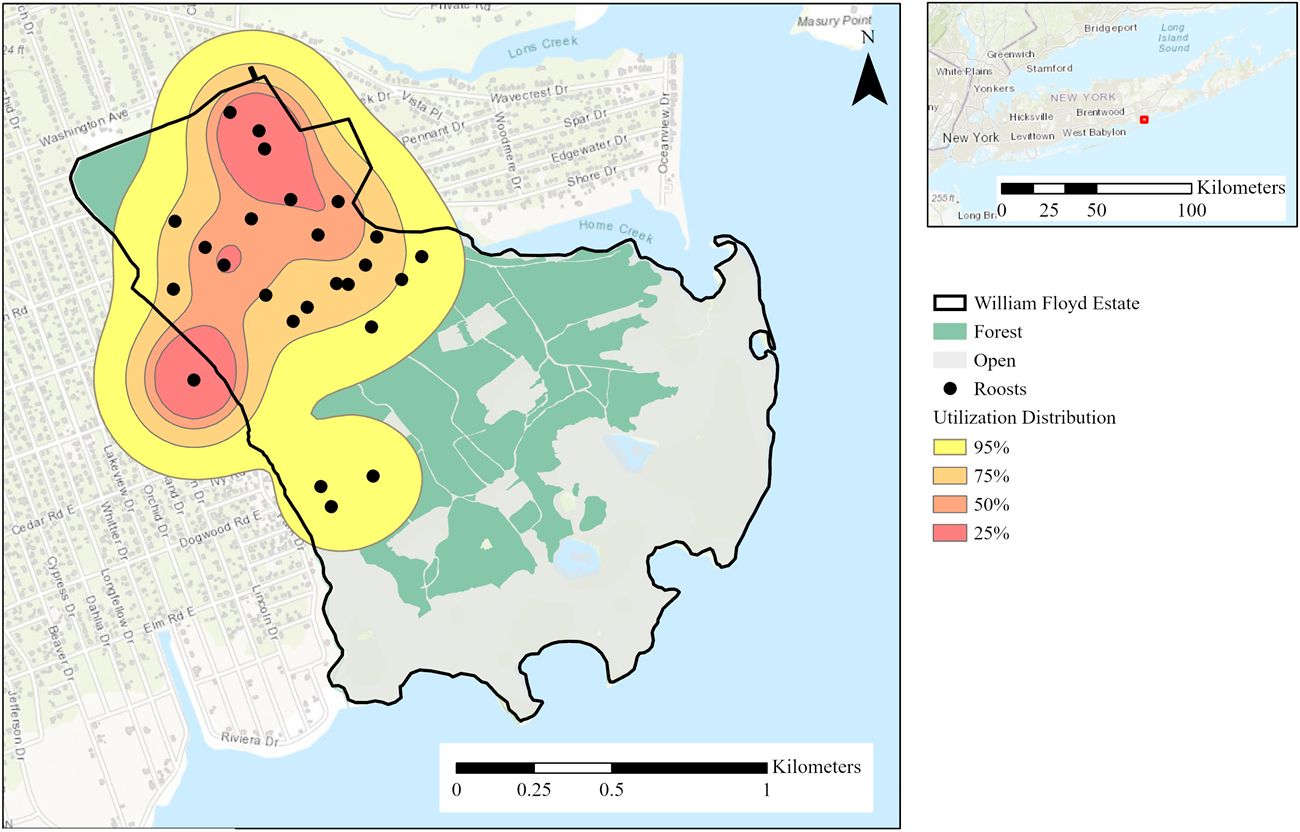
Image credit: U.S. Geological Survey / Katie Gorman
Researchers from multiple agencies and institutions have been working with the park to monitor this population since 2018. Using acoustic detectors, they learned that northern long-eared bats arrive at the estate in March. This seems too early in the year for them to have come from cave hibernacula in the Hudson Highlands, west of New York City. Detectors and mist-net captures also indicate that northern long-eared bats remain on the estate through late October and into early November. This is late enough in the year that movement to the colder interior would be risky. For these reasons, scientists suspect the bats are finding cave-like conditions in local basements, cellars, and cisterns, spending the winter on Long Island rather than trying to migrate through New York City to inland caves.
Although hibernacula on Long Island might not be as ideal as caves, the shorter hibernation period and shorter distance to summer maternity areas may be positive trade-offs.
Why would bats choose to remain on Long Island for the winter? Thanks to the moderating effect of the ocean, winter comes a bit later and spring a bit earlier here compared to the mainland. So although hibernacula on Long Island might not be as ideal as caves, the shorter hibernation period and shorter distance to summer maternity areas like the estate may be positive trade-offs. Northern long-eared bats that overwinter on Long Island may also avoid exposure to white-nose syndrome. That fungus persists within caves and reinfects bats every fall when they return to hibernate.
During the summer, female northern long-eared bats at the estate form one maternity colony of about 15–30 adults. By radio-tagging and tracking nearly all individual estate bats, scientists learn which bats use which roosts and when. Scientists also learn which individuals share roosts, during the few days the transmitter stays on the bat. In the early portion of the maternity season, when the females are pregnant and right after they give birth, females tend to stick together and use a few “super” roosts. By roosting together, female bats conserve warmth, which speeds development of the fetus and newborn pups.
When the pups start to fly, smaller groups of females and their pups start to use other, secondary trees for roosts. But they periodically come back to the initial roost to maintain their social connections to friends and relatives. Bats, just like people, associate with some individuals (acquaintances) here and there and other individuals (family and close friends) all the time.
Study results from the estate shed light on the secretive lives of bat societies. They help land managers understand how to support maternity colonies of northern long-eared bats based on their space and habitat needs. Mapping the bats’ social network and assessing roosts also show how they use day roosts and how vulnerable they are to hurricanes and nor’easters. Intense storms are common on Long Island, and climate change is increasing their frequency and severity. Possibly to hedge their bets against the wind, northern long-eared bats at the estate preferentially use black locust trees and snags.
Though not considered a native plant north of Pennsylvania, black locust was widely planted during Colonial times as a source for fence posts and as an ornamental. It often seeds into abandoned fields, which was the condition of the estate decades ago. This hardy tree is now a naturalized component of the Long Island flora. Black locust is known for hard, durable, and rot-resistant wood that often surrounds internal cavities. Even dead, these trees can persist for decades. So from the bat’s perspective, the black locust provides a home resistant to the forces of nature and reliably present year after year. It’s the bat version of a time-share beach condominium.
An Early-Warning Network for the Northern Great Plains
Early understanding of where white-nose syndrome occurs is critical for land and wildlife managers. It helps them predict where bats may be affected next and evaluate disease impacts. This is particularly important in the Northern Great Plains Network, which includes 13 National Park Service units in Nebraska, North Dakota, South Dakota, and eastern Wyoming. It’s important because across the network, most bats have only recently been affected by white-nose syndrome.
Surveillance that relies primarily on sampling inside hibernacula is not practical in the west. An alternative is to capture bats shortly after they emerge from hibernation.
Where most western bats hibernate is still a mystery, so to determine where the fungus is affecting bats and which species, the network had to get creative. In the east, researchers have monitored large, hibernating colonies of bats annually or semi-annually for decades. Although the western U.S. contains abundant, diverse bat species, such large winter aggregations of bats are much less common there. Some bats hibernate in boulder fields, rock crevices, and other such structures, but these are dispersed and hard to find. As a result, surveillance that relies primarily on sampling inside hibernacula is not practical in the west. An alternative is to capture bats in April and May shortly after they emerge from hibernation. This is no easy task. It is often cold and windy, and the occasional spring blizzard keeps bats from venturing out of their cozy homes.
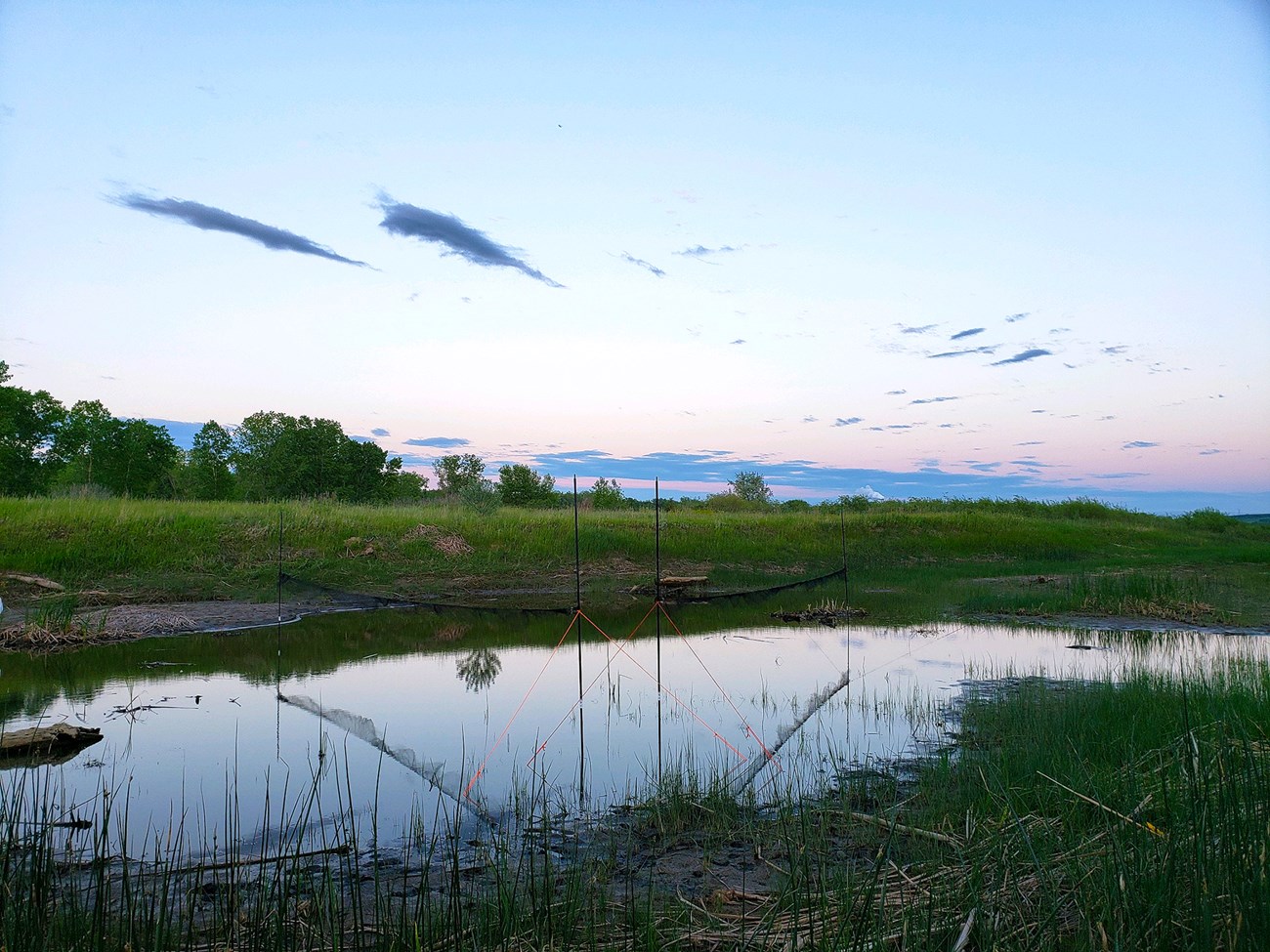
Image credit: NPS
Despite these challenges, since 2018, dedicated bat biologists in the parks and from the University of Wyoming have surveilled for the disease annually across the network. They use mist nets to capture bats near maternity roosts or water. When a bat is captured, they identify the species, determine the sex, and measure key characteristics. They also evaluate the wing and tail membranes, take swab samples of the wing surface, and collect wing biopsies if they see signs of disease. The swab samples are tested in a lab for presence of the fungus, and the wing biopsies are examined microscopically for skin lesions characteristic of white-nose syndrome.
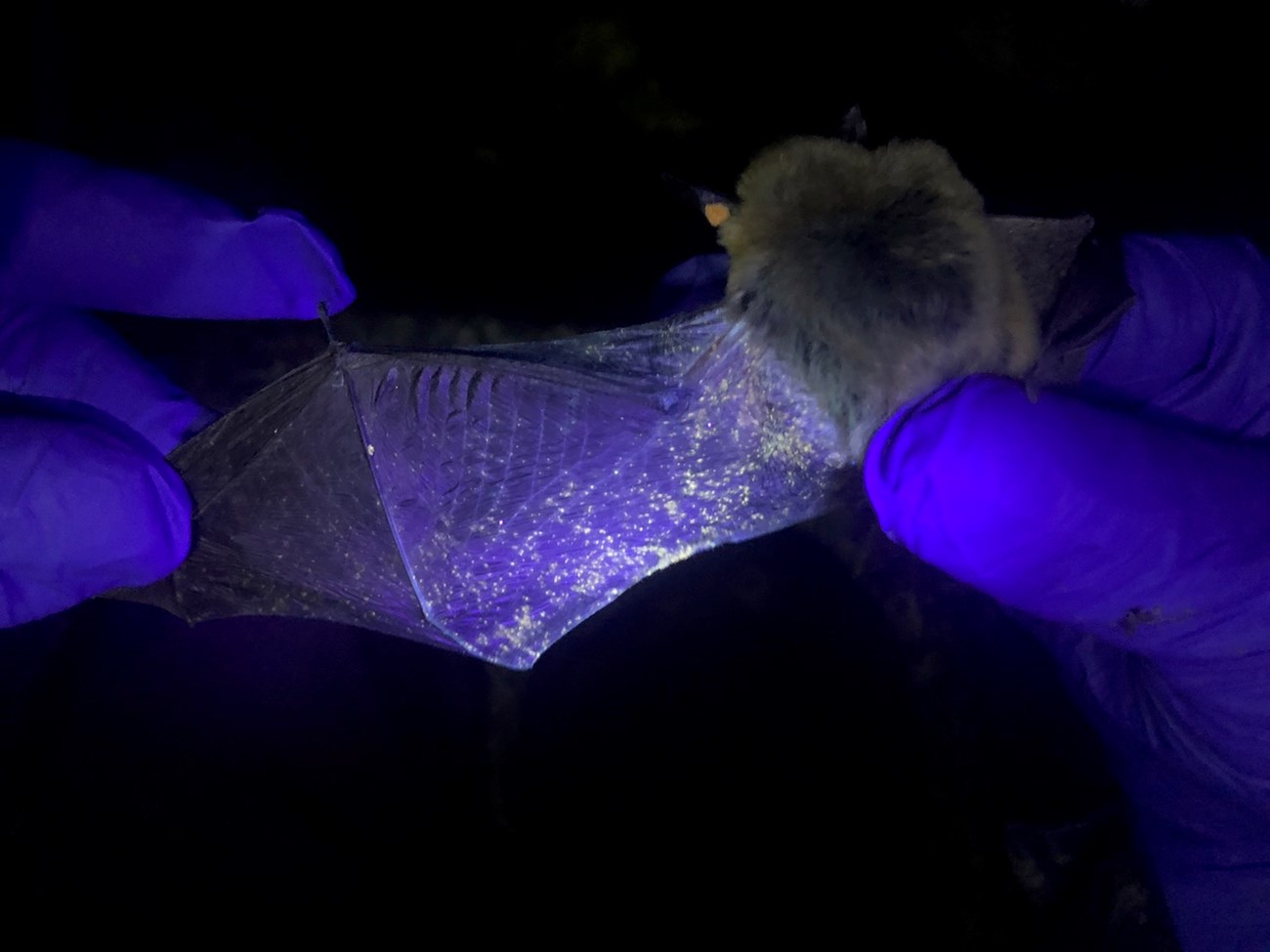
Image credit: NPS / Ian Abernethy (University of Wyoming)
This work has resulted in early detections of the disease across the network. Researchers found white-nose syndrome in bat species not previously known to be affected, including fringed myotis, long-legged myotis, and western small-footed myotis. They also found the first disease occurrences in North Dakota, South Dakota, and Wyoming.
“Wyoming has been on the leading edge of the disease for the last few years. Wildlife managers like me need all the information we can get.”
“Wyoming Game and Fish relies on many partners to help sample for white-nose syndrome throughout the state,” said the department’s bat biologist, Laura Beard. “Early detections…are useful in helping us understand when the fungus arrived and how the disease is progressing. Wyoming has been on the leading edge of the disease for the last few years. Wildlife managers like me need all the information we can get to ensure people aren’t unknowingly spreading [the disease] to new sites and to monitor [its spread in] bat populations.”
The National Park Service faces a similar challenge when responding to white-nose syndrome—visitors. Many parks see hundreds of thousands of visitors from around the world. Reducing the probability that visitors will bring the fungus to parks or take it with them when they leave is a crucial component of our national response. Avoiding disturbing infected bats during hibernation and maternity seasons when they are most vulnerable is especially important. Surveillance can tell individual parks whether their bats have the disease. Parks can then take protective measures such as delaying when cave tours begin and decontaminating gear.
In response to disease presence, Jewel Cave National Monument and Wind Cave National Park in South Dakota now educate their visitors about bats and white-nose syndrome. They also require visitors to decontaminate their footwear before and after cave tours. One study shows park visitors support these management actions.
“[Disease] surveillance and research have led to the consideration of mitigation strategies for recreational activities at the Tower, which is a popular climbing destination,” said Devil’s Tower National Monument resource management chief, Russel Cash. “By considering multiple mitigation strategies, we hope [to] reduce further spread of [the disease] and impacts of white-nose syndrome on the Tower's bat populations.”
At Fort Laramie, Condominium Living Spurs Innovation
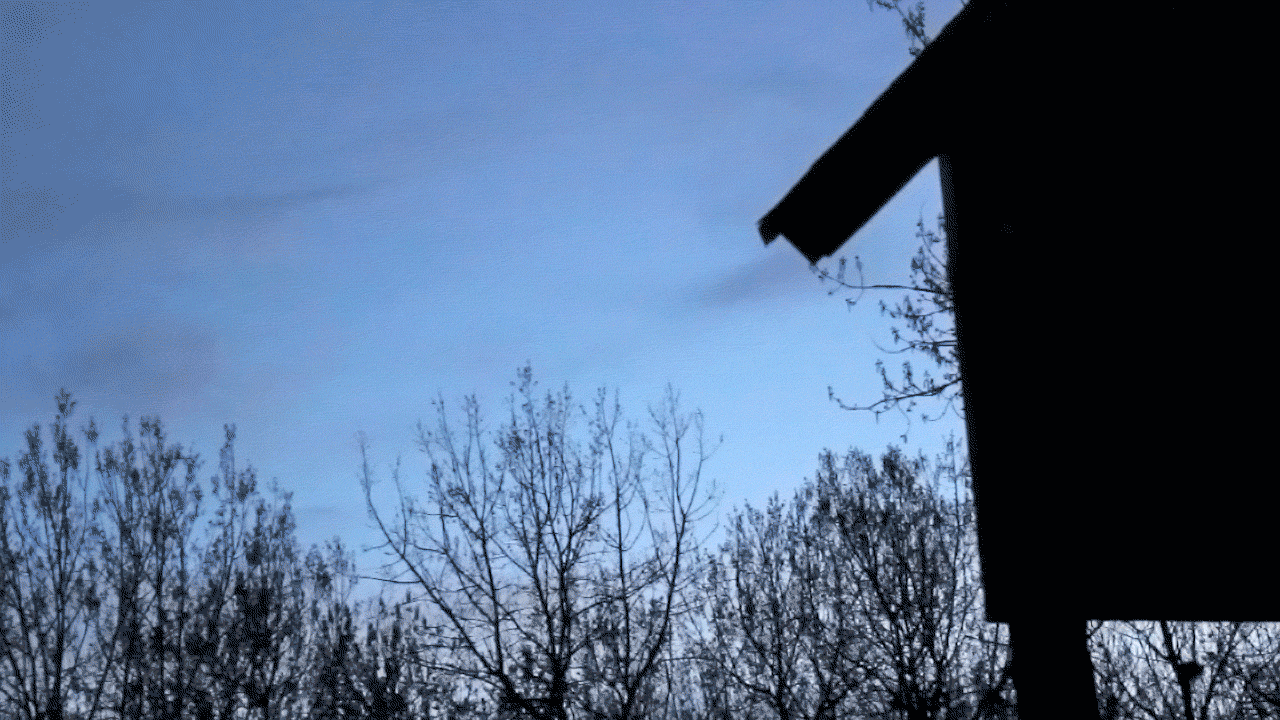
Image credit: NPS / Ian Abernethy (University of Wyoming)
Another solution to studying bats in the absence of large hibernacula is to focus on maternity colonies, where bats also aggregate in large numbers. There can be millions of bats at these colonies, like those under Congress Avenue Bridge in Austin, Texas. Or there can be hundreds. But maternity colonies are large enough for biologists to keep track of numbers and surviving individuals.
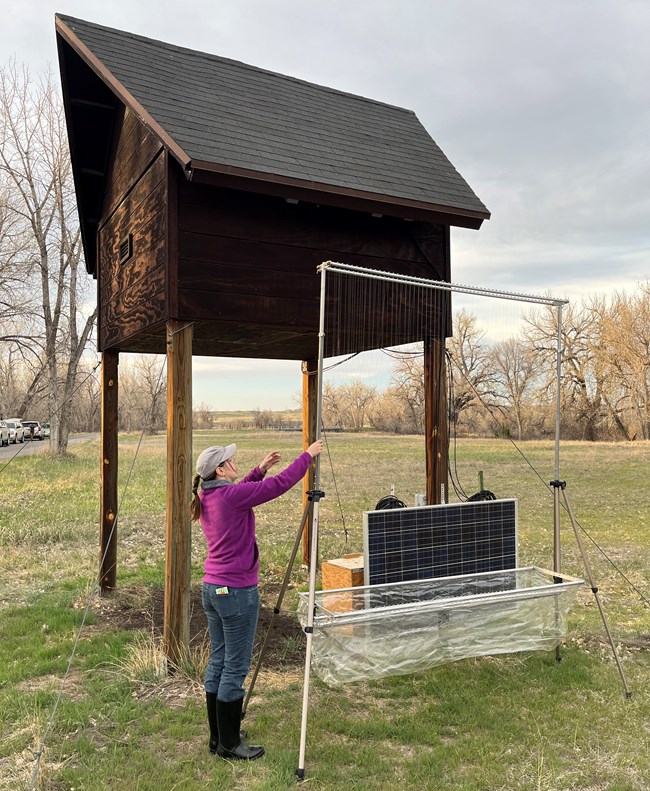
Image credit: NPS / Michelle Verant
“When most visitors think about Fort Laramie National Historic Site, they rarely associate the site with bats,” pointed out Chris Mather, Fort Laramie’s Cultural Resource Program manager, “but the park has a rich diversity of natural resources, including a significant little brown bat population.” Nestled along the North Platte River, Fort Laramie has historic buildings that bats use in the summer. In an attempt to lure them away from these buildings, the park installed a large bat “condominium” near the river.
Mother bats and pups have happily lived here for years in one of the largest known maternal colonies in the region.
This condominium houses thousands of little brown bats, a species that has declined over 90 percent in the eastern portion of its range because of white-nose syndrome. Mother bats and pups have happily lived here for years in one of the largest known maternal colonies in the region. But in 2018, scientists detected the fungus, and they confirmed the disease in bats in 2022.
Working with authors Rob Schorr, a Colorado State University biologist, and Michelle Verant, a National Park Service wildlife veterinarian, Fort Laramie began long-term monitoring for this maternity colony in 2022. Their relatively novel approach uses radio requency identification tags, like the ones inserted under the skin of your dog or cat. The tags make each bat uniquely identifiable. The bats are released once tagged.
The park placed antennae that read the tags at the roost. As the bats come and go during their nightly search for insects, biologists can tell which individuals are using the roost. They can determine whether the bats return each year and estimate the number of bats in the colony. “The park provides a unique situation for studying this disease as it encroaches into the western United States,” Mather noted. “The result of this collaboration brings to light the current consequences and distribution of this insidious disease.”
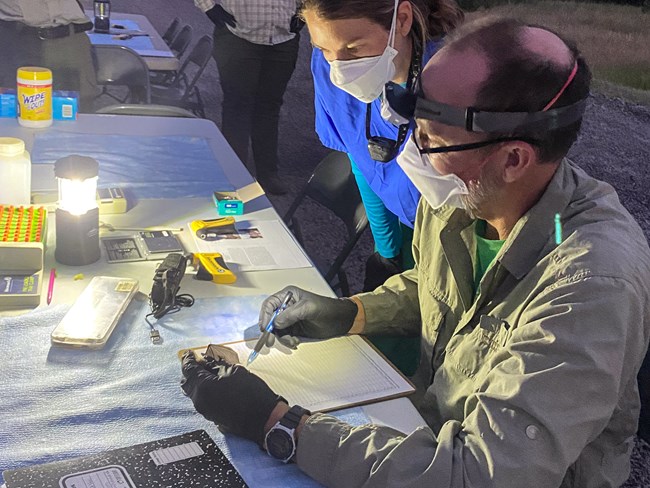
Image credit: NPS / Riley Bernard (University of Wyoming)
There are only a handful of maternity colonies monitored with this technology. But this innovative approach has already improved how scientists monitor bat populations and activity patterns in and outside national parks. By complimenting this study with disease surveillance each spring, Fort Laramie hopes to understand how white-nose syndrome affects their little brown bat populations. For example, the park wants to know the proportion of bats affected each year, which individuals survive, and what makes those individuals special. Tracking individuals also gives scientists a unique opportunity to assess the effectiveness of new treatments like vaccines.
This will be the first vaccination of bats in a national park.
Few strategies are available for reducing white-nose syndrome mortality in bats, and very few vaccines have been developed to protect animals or people from fungal diseases. But this summer, Fort Laramie and its partners plan to work with researchers at the USGS National Wildlife Health Center to vaccinate bats against white-nose syndrome. The work is part of a larger collaborative field trial that includes multiple maternity colonies across the state of Wyoming. This will be the first vaccination of bats in a national park.
Researchers have found the vaccine safe for bats. It reduced infection and improved survival of bats in the lab and in initial field trials. Still, more research is needed to determine its effectiveness in protecting western bats. “The park is excited about participating in this novel and potentially life-saving approach,” said Mather. It will “provide a powerful tool for fighting this disease in bat populations throughout the region.”
Multiple Methods Make a Difference in the Mojave Desert Network
At eight million acres, the Mojave Desert Inventory and Monitoring Network is the National Park Service’s largest such network outside Alaska. In light of emerging threats to bats’ survival and their critical role in desert ecosystems, the network started surveying bats in 2017. Bat diversity is high in the eight network parks, including some that are rare, ecologically important, and susceptible to white-nose syndrome.

Image credit: NPS / Joey Danielson
Bat monitoring now occurs in six parks across the network: Death Valley, Mojave, Joshua Tree, Lake Mead, Great Basin, and Grand Canyon-Parashant. This cost-effective work requires close coordination between park and network staff and uses three survey methods: acoustic, disease surveillance, and bioblitzes.
In four years, the network recorded over 10,000 bat calls and identified at least 20 bat species in the six network parks.
The network follows a modified version of the North American Bat Monitoring Program (NABat), a coordinated, continent-wide assessment of the status and trends in bat populations. This program divides North America into a grid with square cells, which are numbered and prioritized. Our acoustic surveys use a combination of NABat priority cells and other cells expected to have higher bat activity, such as those near water. Two detectors are deployed for four nights per cell in winter and summer.
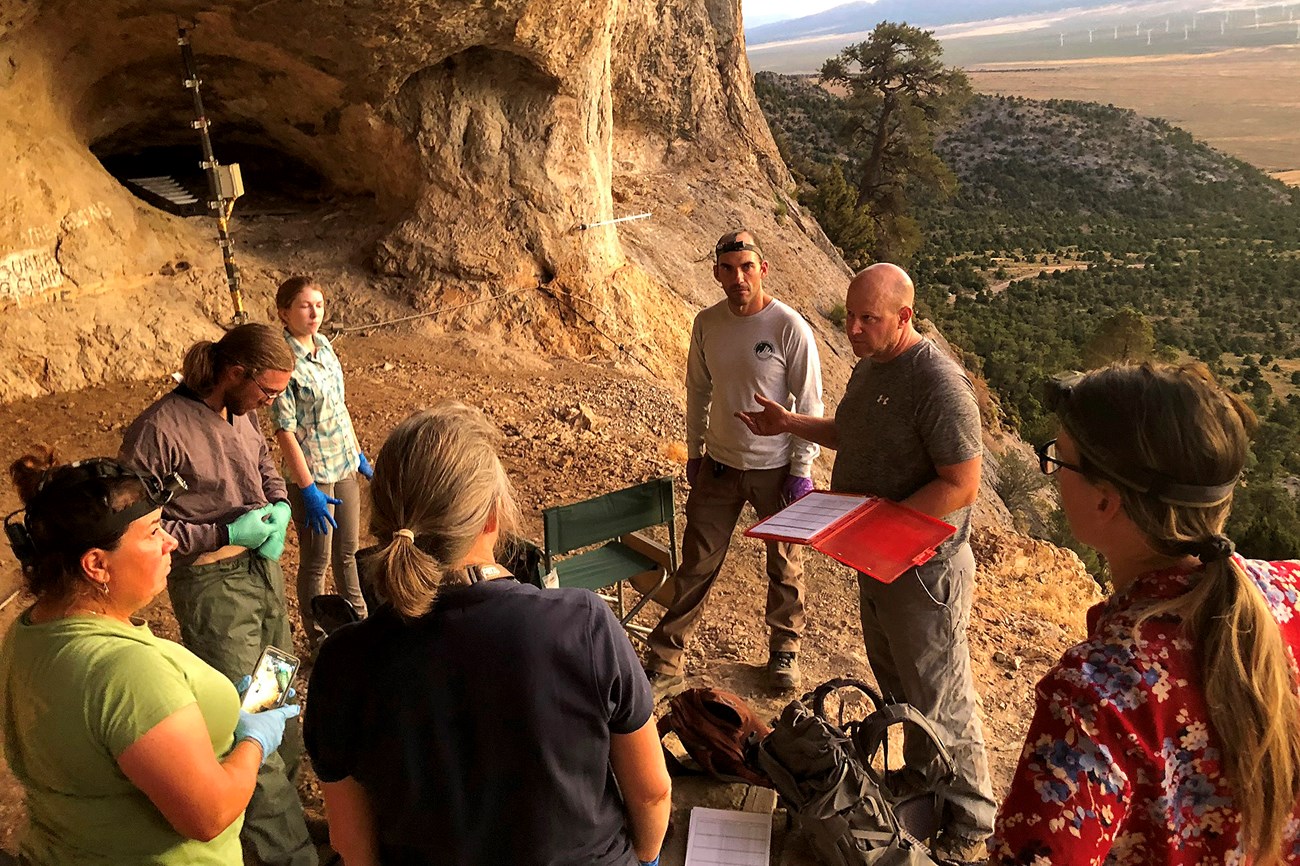
Image credit: NPS / Bryan Hamilton
In four years, the network recorded over 10,000 bat calls and identified at least 20 bat species in the six network parks. Notable species include spotted, western yellow, and western mastiff bats. These results have been used to update bat species lists for the parks and provide site-specific information on bat activity. Integrating these data with NABat data allows scientists to detect local and larger-scale population declines and changes in activity patterns, essential information for managing and conserving bats.
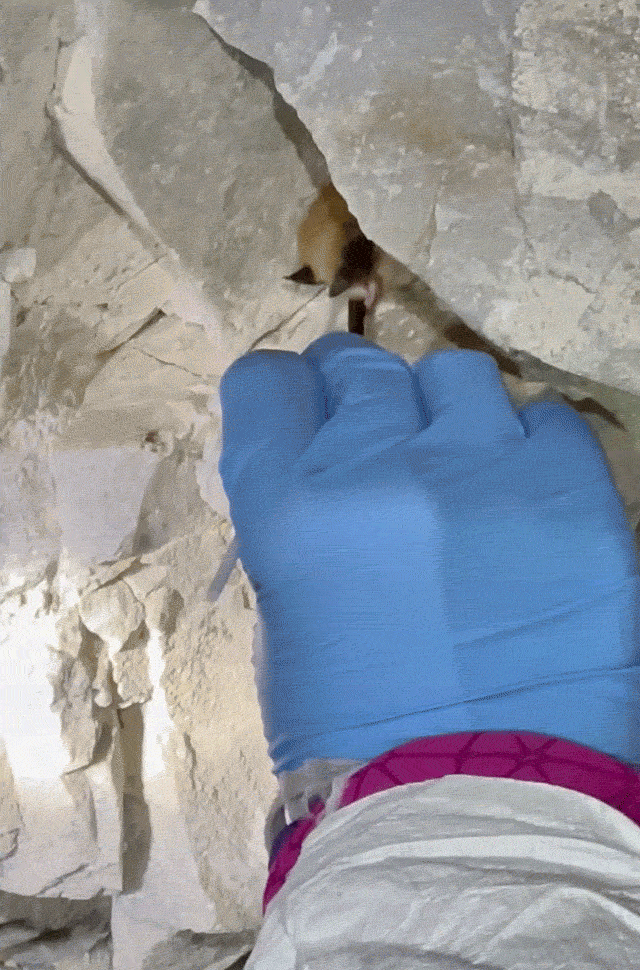
Image credit: NPS / Bryan Hamilton
The fungal pathogen that causes white-nose syndrome is best detected on hibernating bats. But locations where bats hibernate are not known in most network parks in the southwestern U.S. Instead, scientists capture and sample bats for the pathogen in the spring as they emerge from hibernation. One exception is Great Basin, where researchers sample hibernating bats in abandoned mines just outside the park.
Since 2019, the Mojave network and park staff have worked together to capture and swab hundreds of bats. Scientists thought they had detected the fungus on bats in multiple parks in 2021. But despite increased efforts to sample bats in spring 2022, they were unable to detect the fungus again. Although this was certainly good news for bats, it raised lots of questions. And it highlighted the importance of continuing to monitor bats across the region to better understand whether they are affected by the disease.
The work done and data collected at one blitz are far more than a single biologist or small field crew could accomplish in an entire season.
Comprehensive bat surveys using both acoustic and capture methods provide the most complete picture of bat diversity in parks. But these surveys are expensive and time consuming. A bat bioblitz brings together biologists and citizen scientists for coordinated, intensive bat surveys. The work done and data collected at one blitz are far more than a single biologist or small field crew could accomplish in an entire season.
Since 2017, the Mojave network has held bat blitzes at three parks: Grand Canyon-Parashant, Joshua Tree, and Great Basin. The objectives were to document bat diversity, provide training and handling opportunities for biologists, and engage and educate the public. The bat blitzes were wildly successful, capturing hundreds of bats and recording thousands of calls. Participants identified 17 species, giving scientists a more complete picture of bat diversity in the network. The blitzes were also important for training and collaboration. Biologists from 13 parks and three state wildlife agencies networked and trained together, setting the stage for future partnerships.
These different survey methods have provided valuable data on bats across one of the largest networks in the National Park Service. These data have helped the network determine species-habitat relationships, identify threats and how to address them, and build a platform for future monitoring. But the work isn’t done. Scientists and park staff will continue these surveys and bioblitzes. They will show how bat species richness and activity levels change over time and across the network, helping managers conserve the high bat diversity in their parks. The network has also contributed these data to NABat for regional and range-wide assessments of species status and trends.
Working Together to Give Them a Chance
White-nose syndrome continues to be one of the deadliest emerging diseases for wildlife in North America. It has drastically altered bat communities and driven some species to near extinction, with ripple effects on the health of our forests, crops, and ecosystems. Despite this destruction, there is hope. Prior to the arrival of white-nose syndrome, we knew relatively little about bats in North America. But over the past decade, scientific research, monitoring, and conservation inside and outside national parks have improved our understanding of these unique and ecologically important animals.
Sharing what we learn through interpretive programs and events like Bat Week promotes positive attitudes towards these “creepy” yet charismatic creatures. The dangers from white-nose syndrome and other threats to bats are far from over. But coordinating our scientific discoveries and actions to protect them with partners, networks, parks, and people across the nation will give bats a fighting chance.

Image credit: NPS / Bryan Hamilton
About the authors


Bik Wheeler is the lead wildlife biologist at Acadia National Park. He works to conserve the park’s wildlife populations through monitoring and research. Bik delights in the diversity of animal behavior, particularly when populations use unexpected life history strategies. Image © Friends of Acadia National Park / W. Greene

Mark Ford is the unit leader of the U.S. Geological Survey’s Virginia Cooperative Fish and Wildlife Research Unit at Virginia Tech where he directs and manages a team of graduate students and research associates studying bats and their forest habitat relationships. Image courtesy of Mark Ford.

Ian Abernethy is the Vertebrate Zoology Program manager at the University of Wyoming’s Wyoming Natural Diversity Database. Ian has researched bats in Wyoming and other western states for over a decade. Image courtesy of Ian Abernethy.

Rob Schorr is a conservation zoologist for the Colorado Natural Heritage Program at Colorado State University and has studied population ecology of rare plant and animal species for 25 years. He is the director of Climbers for Bat Conservation and current president of the Western Bat Working Group. Image courtesy of Rob Schorr.

Allen Calvert has been the network program manager at the Mojave Desert Inventory and Monitoring Network since 2016. Prior to that, he worked as a biologist with the Bureau of Reclamation's Lower Colorado River Multi-Species Conservation Program, where he was the species lead for bats, rodents and amphibians. He has been developing and implementing research and monitoring projects for bats since 2007. Image courtesy of Allen Calvert.

Bryan Hamilton is a wildlife biologist at Great Basin National Park. His interests include conservation biology, bats, bighorn sheep, and rattlesnakes. Bryan has three kids and lives in Baker, Nevada. Image courtesy of Bryan Hamilton.

Kimber Godfrey is a biological science technician who has been working at Mojave Inventory and Monitoring Network for four years as the lead on their bat monitoring program. She worked previously at Pinnacles National Park with raptors and condors and at the Klamath Inventory and Monitoring Network with bats and in interpretation. She has a degree in ecology from Humboldt State. Image courtesy of Kimber Godfrey.
Tags
- acadia national park
- catoctin mountain park
- chesapeake & ohio canal national historical park
- death valley national park
- devils tower national monument
- fire island national seashore
- fort laramie national historic site
- grand canyon-parashant national monument
- great basin national park
- jewel cave national monument
- joshua tree national park
- lake mead national recreation area
- mojave national preserve
- prince william forest park
- rock creek park
- shenandoah national park
- wind cave national park
- park science magazine
- park science journal
- ps v37 n1
- features
- wildlife
- animals
- bats
- disease
- white nose syndrome
- wns
- nabat
- bioblitz
- research
- conservation
- michelle verant
- bik wheeler
- mark ford
- ian abernethy
- rob schorr
- allen calvert
- bryan hamilton
- kimber godfrey
- mojave desert network
- stories by women authors
